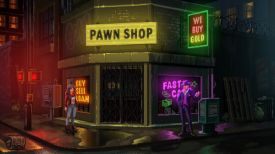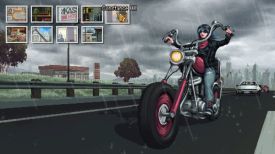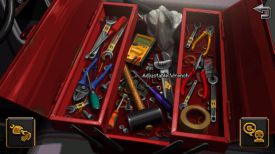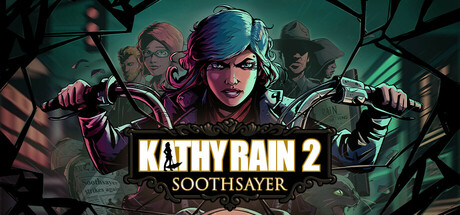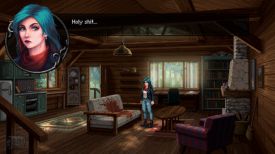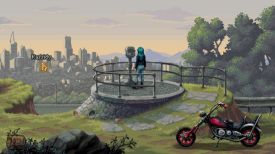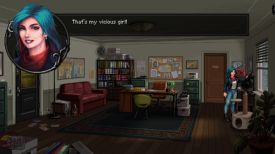|
By flotsam
Kathy
Rain 2: Soothsayer
Clifftop Games / Raw Fury
This is high quality pixel art,
and despite a few quibbles, it's high quality adventuring as well.
I didn't play the first game
(which this game recommends doing when you first start it up), but you
get the option to recap what went before. While that gave me a sense of
Kathy’s earlier exploits, having completed the game, while I didn’t feel
all at sea by any means, I certainly think that playing the first game
will enable you to get the most out of the tale. I won’t say more to
avoid any spoiling.
As the Steam page says "When
this story begins, things are looking dire for private eye Kathy Rain.
It’s the year 1998, and she is utterly broke: The Katmobile (her
motorbike) is running on fumes, the fridge is nearly empty, and an
eviction is looming close. However, opportunity arrives when a big cash
reward is announced for solving the 'Soothsayer' case — a string of
serial murders with a death grip on the metropolitan city of Kassidy."
And so Kathy gets to
investigating.
I liked a lot how the first day
was put together. I got a good feel for how all the mechanics worked,
and while I uncovered lots of possible leads and opened new locations,
Kathy steadfastly held to her "gather information" approach before
following everything up. Which didn't mean she didn't ask questions
about learned topics (helpfully gathered and activated through your
notebook), but when you know next to nothing, best to be as informed as
possible.
Which meant much of that day was
spent at the library, winkling stuff out of the archives. What to look
for and when was what was demanded, and I thought it was a well
constructed puzzle in that it did feel like actually joining the
information dots. It took me a little while to grasp the 'how' and a
fair bit longer to get to the end, but it was very satisfying.
It was also a good precursor for
the next five days. It will give you a good feel for what the game wants
from you in terms of its ‘puzzling.'
Mechanics wise the game is all
point and click, the visuals richly detailed in their pixelly way, and
while there is not a lot of background motion it doesn't feel lifeless.
Some locations visually sing, Tabitha’s Garden being one of those. It
never ceases to amaze me how good looking pixels can be.
You can die, or fail to stop
someone else from dying, or be caught doing something you shouldn’t and
perhaps a few other things that will see the screen go white, after
which you will be returned to the start of the sequence and get to try
again. Some of these sequences were a bit too trial and error, but it is
also possible I missed the clue to make them less so. Regardless, they
aren’t too difficult so they didn’t interrupt my enjoyment.
Far more satisfying are puzzles
like the archive. Two later ones (one involving a pager, the other a
computer hack) were a highpoint for me, requiring a fair degree of
deductive nous, preceded by a similar degree of head scratching.
Finding and using items (and
combining where required), as well as asking the right questions of the
right people, provide the bulk of the conundrums. It pays to search
thoroughly and question people in the same way, as a number of triggers
rely on enquiring about the right topic.
It’s also worth knowing that
certain items won’t be able to be gathered until you have a reason to do
so, and some information acts in the same way (i.e., reading a document
might not trigger a way forward until other information comes to light).
It makes sense - why get a random item until it isn’t, why would mundane
information be important until it is – so long as all items act in the
same way. Not all of them do (meaning you can gather some items before
having an obvious reason), and while I acknowledge that certain items
might be generically useful in the future and therefore worth picking up
(a multi tool perhaps?), I don’t think all the items I gathered could be
seen in that way.
Which isn’t a big thing, but it
is a thing nonetheless. How you feel about it will be up to you.
It does mean that you will go
back and forth, and revisit information, but I suspect you will do that
anyway. You will open up around 20 locations across the course of the
game, and while some will be ‘closed’ to you at times (Kathy might say
something like, “I don’t need to go there now” or “I should leave X
alone”), revisiting scenes and characters is a necessary aspect of
moving things forward. Like many games, answers to questions from one
character can open fresh lines of enquiry with others, and so on.
In that regard, your notebook is
your go-to item. It collects the various subjects you can ask about, as
well as the phone numbers you can ring. There is also a way you can ask
about items in the game world, and the game itself will explain that
aspect to you, as it does for other things as you move along. The
notebook also includes your various investigative objectives, and
interrogating these might reveal a way forward.
The notebook and the items you
gather are in your kit-bag bottom left. Click to open the bag, and then
hold and drag to use an item in the world.
Hotspots can be revealed with
the space bar, and along with the feedback from the game I didn’t think
that it was a hard game, but some puzzles were certainly challenging. I
did need a prompt from outside the game on occasion, and there is a
rather good hint based walkthrough you can find online should you need
help. I was also lost occasionally as to what to do next, but revisiting
locations, requestioning people and interrogating my objectives tended
to get me through. Randomly using items everywhere wasn’t a thing;
asking a character everything possible was far more likely.
Some scenes slide as you
explore, others are limited to what you see. When you exit a particular
scene, you get an animation of Kathy on the Katmobile, and you then
choose the destination from the location icons that accumulate as you
explore. Kathy won’t run but she will jump to an exit point with a
double-click. You can save at will (it also autosaves on exit) and tweak
a few settings.
Conversations involve a large
pop-up head-shot of the participants. Voice acting was generally
excellent. The plot took a turn that didn’t really do it for me, and the
last part of the game felt somewhat weighed down by exposition. That
said, I really liked how it finished.
I look forward to more from
Kathy.
I played on:
OS:
Windows 11, 64 Bit
Processor: Intel i7-9700K 3.7GHz
RAM:
Corsair Dominator Platinum RGB DDR4 32GB
Video
card: AMD Radeon RX 580 8192MB
GameBoomers Review Guidelines
August 2025
design copyright© 2025
GameBoomers
Group
 GB
Reviews Index GB
Reviews Index |
